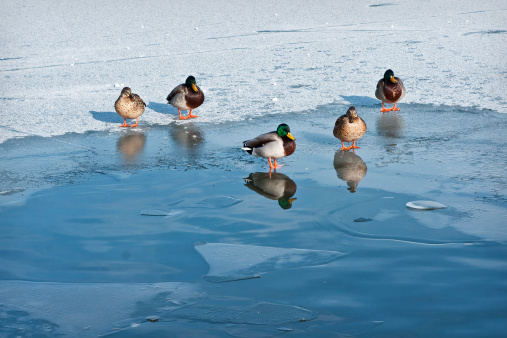DELMAR, N.Y. – The Niagara River corridor from Lake Erie to Lake Ontario is renowned as a spectacular winter haven for hundreds of thousands of water birds. But this year’s bitterly cold season has made it notable for something else: dead ducks.

Biologists say carcasses began piling up by the hundreds in early January after the plunging temperatures started icing over nearly the entire Great Lakes, preventing the ducks from getting to the minnows that are their main source of food. Necropsies on dozens of birds have confirmed the cause: starvation.
“All have empty stomachs. They’re half the weight they should be,” said Connie Adams, a biologist in the state Department of Environmental Conservation’s Buffalo office who has personally seen 950 dead birds.
“This is unprecedented. Biologists who’ve worked here for 35 years have never seen anything like this,” she said. “We’ve seen a decline in tens of thousands in our weekly waterfowl counts.”
It’s a phenomenon that has been seen elsewhere along the Great Lakes, with news reports of diving ducks and other waterfowl turning up dead by the hundreds along the southern part of Lake Michigan. They’ve also been found in Lake St. Clair between Lakes Erie and Huron.
“It’s a hard winter for ducks, like everything else,” said Russ Mason, wildlife director with the Michigan Department of Natural Resources.
- Ontario takes action against chemical plant after Aamjiwnaang First Nation residents fell ill
- High benzene levels detected near Ontario First Nation for weeks, residents report sickness
- Enter at your own risk: New home security camera aims paintballs at intruders
- Beijing orders Apple to pull WhatsApp, Threads from its China app store
Necropsies and toxicity analyses showed many of the Michigan ducks were subsisting on invasive zebra mussels, which caused the birds to have potentially toxic levels of selenium in their bodies, Mason said. Zebra mussels filter toxins from the water and pass them up the food chain.
Most of the dead ducks seen in the upstate New York are red-breasted mergansers, which breed in northern Canada and Alaska and come south for the winter to the Great Lakes region. In most years, there are periods of freezing and thawing, providing enough breaks in the ice for them to dive for minnows.
But this winter, it’s been so bitterly cold for so long that the ice had pushed across 92.2 per cent of the Great Lakes’ surface area earlier this month, according to federal monitors, just short of the record 94.7 per cent set in 1979.
Biologists say the Niagara River also has ice extending up to 100 yards off shore, creating a shelf where minnows and shiners can hide.
There is evidence some waterfowl gave up and tried to fly farther south but were too weak to do so. Dead birds have been seen along shorelines, on docks and on the ice, their carcasses feasted upon by gulls and bald eagles.
Two weeks ago, Adams said, there were 240,000 water birds in her area’s weekly count. Last week, there were 43,000. It’s unknown how many birds – which also included such species as scaup, canvasbacks and grebes – migrated elsewhere and how many died.
At the DEC’s Wildlife Health Unit near Albany, biologist Joe Okoniewski has refrigerators stuffed with bags of red-breasted mergansers sent by wildlife biologists on Lakes Erie and Ontario. The diving ducks are black and white with a rusty speckled breast, orange bill and an iridescent green head with a shaggy crest on the back.
“The skin is stuck tight to the body wall because there’s no layer of fat underneath,” Okoniewski said, running a scalpel along the breastbone of a dead merganser. The gizzard and intestine were empty, except for a few normal parasites.
“I’ve seen a couple with stomachs full of feathers and feathers all the way down through their intestines,” Okoniewski said. “They’re desperate for anything to eat. It’s really sad.”
Unlike mallard or black ducks, mergansers won’t eat bread or other food people may offer. They only eat live fish.
While the bird deaths are a natural event that can be documented but not changed, wildlife rehabilitators are trying to save birds that people find near death in snowbanks and parking lots.
“We’ve had over 160 since the beginning of January,” said Dawn Mazierski, a wildlife technician at the Erie County SPCA in Tonawanda. “We have to tube-feed them a liquid diet three to four times a day until they’re strong enough to eat on their own.”
The birds, which spend all their time on water, can hardly walk, and often their natural waterproofing is damaged by dirt or road salt so they can’t swim either. “They soak up water like a sponge and sink,” Mazierski said.
So the birds rest in a quiet room on net hammocks called loon beds, preening their feathers back to condition. When they’re ready, they go into tubs of water stocked with minnows donated by bait shops.
“A merganser can eat 200 to 250 fish per day,” Mazierski said. “We go through thousands of fish a day.”
After anywhere from three days to a couple of weeks, the birds are ready for release.
“Once their weight has increased and they’re real spunky, and we have a decent weather day, we take them back out,” Mazierski said. “And we hope they’ll find enough food to bulk up for their flight north in spring.”
—
AP Environmental Writer John Flesher in Traverse City, Mich., contributed to this report.



Comments